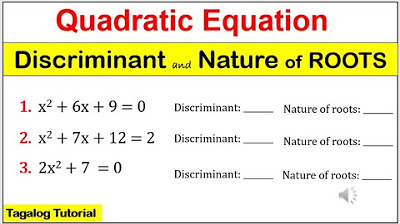Polinomial (Bagian 5) - Cara Menentukan Akar-akar Persamaan Polinomial
Summary
TLDRThis educational video script focuses on polynomial equations, teaching viewers how to identify and determine their roots. It explains the general form of a polynomial equation, which is a polynomial set equal to zero. The script provides examples of polynomial equations and their roots, illustrating the process of finding roots through substitution and factoring. It also introduces the concept of discriminants in quadratic equations and their role in determining the nature of roots. The tutorial aims to deepen understanding of polynomial equations and their applications.
Takeaways
- 📚 The video is an educational tutorial on polynomial equations, focusing on understanding and finding the roots of polynomials.
- 🔍 It explains that a polynomial equation is a polynomial set equal to zero, and the roots are the values of the variable that satisfy this equation.
- 🌱 The video provides an example of a cubic polynomial equation and demonstrates how to find its roots by substitution.
- 🔢 The presenter shows that a cubic polynomial can have up to three roots and that these roots can be found by factoring the polynomial.
- 📝 The process of factoring a polynomial is discussed, including determining possible roots by dividing the constant term by the leading coefficient.
- 📉 The concept of the discriminant is introduced to determine the nature of the roots for quadratic equations, with negative discriminants indicating no real roots.
- 📚 The tutorial covers how to verify potential roots by substituting them back into the polynomial equation.
- 📉 The video also explains that if the discriminant is zero, there will be one repeated root, and if it's positive, there will be two distinct real roots.
- 📝 The presenter uses the Horner's method for polynomial division to simplify the process of finding the remaining factors after identifying an initial root.
- 🔑 The video concludes with a discussion on Vieta's formulas, which will be covered in a future tutorial to find the sum and product of the roots without explicitly determining each root.
- 👋 The video ends with a sign-off greeting, indicating the end of the educational content.
Q & A
What is the general form of a polynomial equation?
-The general form of a polynomial equation is a polynomial set equal to zero, typically represented as P(x) = 0, where P(x) is a polynomial expression.
What are the roots of a polynomial equation?
-The roots of a polynomial equation are the values of the variable that satisfy the equation, making the polynomial equal to zero.
Can you provide an example of a polynomial equation from the script?
-An example of a polynomial equation from the script is 2x^3 - 3x^2 + 4x + 16 = 0.
How can you determine if a value is a root of a polynomial equation?
-You can determine if a value is a root by substituting it into the polynomial equation and checking if the result is zero.
What is the maximum number of roots a cubic polynomial equation can have?
-A cubic polynomial equation can have a maximum of three roots.
What is the process of finding the roots of a polynomial equation?
-The process of finding the roots of a polynomial equation involves factoring the polynomial and setting each factor equal to zero to solve for the variable.
How can you factor a polynomial equation?
-You can factor a polynomial equation by finding its factors, which are expressions that multiply together to give the original polynomial.
What is the discriminant in the context of a quadratic equation?
-The discriminant of a quadratic equation (ax^2 + bx + c = 0) is given by the expression b^2 - 4ac, and it determines the nature of the roots of the equation.
What does a negative discriminant indicate for a quadratic equation?
-A negative discriminant indicates that the quadratic equation has no real roots, implying that the roots are complex numbers.
What is the significance of the coefficients and constant in factoring a polynomial equation?
-The coefficients and constant in a polynomial equation are significant in factoring as they determine the possible factors and roots of the equation.
Can you explain the 'Horner's method' mentioned in the script for polynomial division?
-Horner's method, also known as the synthetic division, is a technique used to evaluate polynomials and divide them efficiently by linear factors.
Outlines

Cette section est réservée aux utilisateurs payants. Améliorez votre compte pour accéder à cette section.
Améliorer maintenantMindmap

Cette section est réservée aux utilisateurs payants. Améliorez votre compte pour accéder à cette section.
Améliorer maintenantKeywords

Cette section est réservée aux utilisateurs payants. Améliorez votre compte pour accéder à cette section.
Améliorer maintenantHighlights

Cette section est réservée aux utilisateurs payants. Améliorez votre compte pour accéder à cette section.
Améliorer maintenantTranscripts

Cette section est réservée aux utilisateurs payants. Améliorez votre compte pour accéder à cette section.
Améliorer maintenantVoir Plus de Vidéos Connexes

Solving Polynomial Equations By Factoring and Using Synthetic Division

Jenis-jenis akar persamaan kuadrat || akar real berbeda, akar real sama, akar tidal real (IMAJINER)

X- AND Y- INTERCEPTS OF GRAPHS OF POLYNOMIAL FUNCTION|| GRADE 10 MATHEMATICS Q2

Polynomials - Classifying Monomials, Binomials & Trinomials - Degree & Leading Coefficient

MATH9 DISCRIMINANT and NATURE OF ROOTS of quadratic equation #math9 #discriminant #natureofroots

Polynomial Functions - Polynomial Function or NOT? Grade 10 Math Second Quarter
5.0 / 5 (0 votes)
